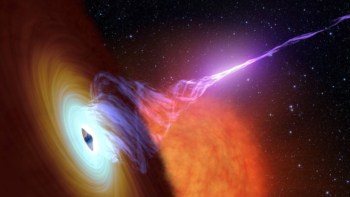
If you pour water out of a bottle, the liquid stream will often adopt a chain-like structure. The physics behind this curious phenomenon has been hotly debated for more than a century, but now this mystery may have been solved by experiments done by Antoine Deblais, Daniel Bonn and Daniel Jordan at the University of Amsterdam and Neil Ribe at the University of Paris-Saclay.
When a jet of liquid drops from a non-circular nozzle it can form a wave of broad, flattened and evenly spaced sections of liquid that are alternately oriented at 90° to each other. These sections are separated by thinner links of liquid – making the structure resemble a chain (see figure).
At the heart of the effect is the non-cylindrical profile of the jet as it emerges. To minimize surface tension, the jet tries to become a cylinder, but this motion overshoots and results in an oscillation in the profile shape.
However, there is a long-standing disagreement between two theories that describe how these oscillations occur. One theory was put forward by Lord Rayleigh in 1879, and it was then modified by Niels Bohr in 1909. Rayleigh’s theory describes the oscillation as a linear effect, whereas Bohr’s theory introduces nonlinear effects that decrease the frequency of the oscillations as their amplitude increases.
Bohr wins out
Until now, no experiments have determined which of these theories offers a more accurate description. To resolve this issue, Deblais’ team designed a series of 12 elliptical nozzles with varying sizes and eccentricities. Then they measured both the frequencies and amplitudes of the chain structures which formed as they poured water through the nozzles at varying flow rates. While the patterns they observed disagreed slightly with Rayleigh’s predictions, they aligned more strongly with Bohr’s theory.
Based on their results, Deblais and colleagues constructed numerical simulations of liquid chain oscillations – again, finding a strong agreement with Bohr’s predictions. Their results also help to explain why the surface of each jet became dimpled during their experiments – another interesting feature of everyday water jets. The team now hopes to extend the experiments and simulations to consider liquids other than water, as well as nozzles with more complex shapes.
Now that a basic theory has been established, future experiments could offer useful insights in a diverse range of applications where liquids are fired from elliptical nozzles, including ink-jet printing and metallurgy. Further research could also lead to new techniques for enhancing combustion efficiency, suppressing noise, or improving control over thrusters. Elsewhere, the findings could help researchers to better understand the emergence and possible treatment of certain medical issues, including urological diseases.
Recent Comments

Astronomers detect first direct image of black hole expelling a powerful jet

Artificial Intelligence Discovers Hidden Giant, a Planet 5 Times Larger Than Jupiter

Scientists explain melting of Antarctic ice sheet dating back 9,000 years

An Unexpected Discovery: Hubble, ESA's Gaia Spot Double Quasar That Existed Over 10 Billion Years Ago

Casino Table Games How to Play ➤ Master Rules & Strategies for Wins

How to Win Playing Online Casino ➤ Proven Strategies & Tips

22BET - Scommesse Sportive Online con le Migliori Quote


